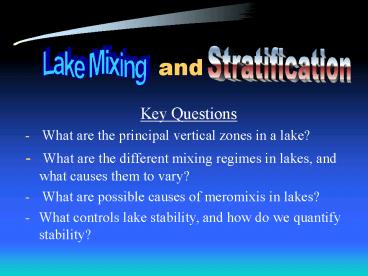Heat and stratification - PowerPoint PPT Presentation
1 / 18
Title:
Heat and stratification
Description:
L&O 41: 912-920. Salinity. Salt increases density ... Salinity strongly affects stratification and density, and is very important to meromixis ... – PowerPoint PPT presentation
Number of Views:34
Avg rating:3.0/5.0
Title: Heat and stratification
1
and
Stratification
Lake Mixing
- Key Questions
- What are the principal vertical zones in a lake?
- What are the different mixing regimes in lakes,
and what causes them to vary? - What are possible causes of meromixis in lakes?
- What controls lake stability, and how do we
quantify stability?
2
Light and energy distribution
Source of heat for most lakes is
atmosphere/solar. Water conducts heat
poorly. What might temperature profile be?
Temperature
0 10 20
z
z
3
Common temperature profiles
Observed temperature profiles in lakes deviate
significantly from distribution of energy
input. Why? - Wind stress does work on
lake surface - Diel/weekly density-driven
currents
t
Temperature 4 25
0 10 20
Light
Winter
z
z
Summer
4
Density characteristics of water
Ice
From Denny 1993
5
Vertical Zonation in Lakes
t
Temperature
0 10 20
Inverse/ Normal
Epilimnion Metalimnion/
Thermocline Hypolimnion
z
z
6
Seasonal Patterns
What determines hypolimnetic temperature in
summer?
Winter Spring Summer Fall
t
t
t
tv
Temperature
Temperature
Temperature
Temperature
0 10 20
0 10 20
0 10 20
0 10 20
z
z
z
z
z
z
z
z
Inverse Isothermal Normal
7
Annual temperature changes in a dimictic
temperate lake
8
Lake Mixing Types Climate and latitude
Amictic ice-covered Cold monomictic Cold
polymictic Dimictic Warm polymictic Warm
monomictic Oligomictic
Hutchinson 1957
9
(No Transcript)
10
Mixed Layer Depth and Productivity
11
Factors determining the depth of the thermocline
Wind and Morphology
- Mixing depth ? Area0.25
- Importance of fetch
12
Factors determining the depth of the thermocline
Morphology and Transparency/radiation
Fee, EJ et al. 1996. Effects of lake size, water
clarity, and climatic variability on mixing
depths in Canadian Shield lakes. LO 41 912-920
13
Salinity
Salt increases density
????999.8425940.06793952(T)-0.00909529(T)20.
0001001685(T)3-0.000001120083(T)40.0000000065
36332(T)50.824493(S)-0.0040899(T)(S)0.00007
6438(T)2(S)-0.00000082467(T)3(S)0.000000005
3875(T)4(S)-0.00572466(S)1.50.00010227(T)(
S)1.5-0.0000016546(T)2(S)1.50.00048314(S)2
14
More mixing terms
- Holomictic Meromictic
Mixolimnion
Monimo- limnion
15
Salinity and Meromixis
Salinity gradients can overcome thermal
gradients E.g. Lake Nyos, Lake Kivu
16
Salt sources and types of Meromixis
Crenogenic Meromixis inputs of salt from saline
springs Biogenic meromixis Decomposition of
organic matter Ectogenic external inputs of
salt water Cryogenic meromixis Salt exclusion
from ice
17
Resistance to mixing and stability
- (?1- ?2) / (z2-z1)
18
Conclusions
- Heat inputs, outputs, and wind mixing cause most
lakes to thermally stratify into an epilimnion,
metalimnion (thermocline) and hypolimnion - Wind speeds and exposure (fetch), and
transparency affect the depth of a lakes
epilimnion - Temperature and seasonality regulate lake mixing
regime - Salinity strongly affects stratification and
density, and is very important to meromixis - Lake stability is related to the strength buoyant
forces (the density gradeint) relative to kinetic
energy (surface waves and currents)































